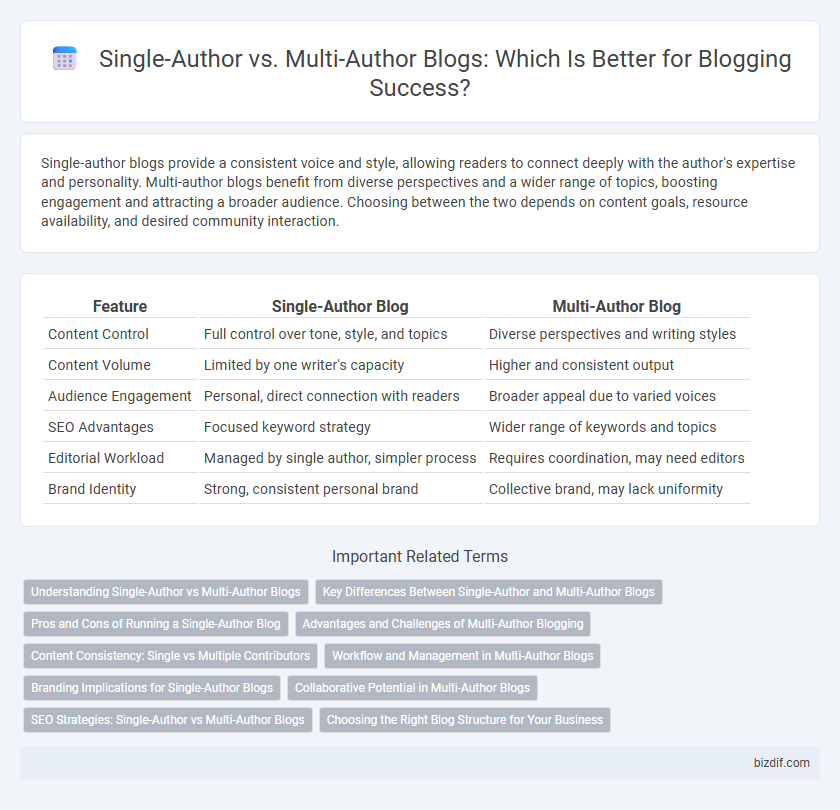Single-author blogs provide a consistent voice and style, allowing readers to connect deeply with the author's expertise and personality. Multi-author blogs benefit from diverse perspectives and a wider range of topics, boosting engagement and attracting a broader audience. Choosing between the two depends on content goals, resource availability, and desired community interaction.
Table of Comparison
| Feature | Single-Author Blog | Multi-Author Blog |
|---|---|---|
| Content Control | Full control over tone, style, and topics | Diverse perspectives and writing styles |
| Content Volume | Limited by one writer's capacity | Higher and consistent output |
| Audience Engagement | Personal, direct connection with readers | Broader appeal due to varied voices |
| SEO Advantages | Focused keyword strategy | Wider range of keywords and topics |
| Editorial Workload | Managed by single author, simpler process | Requires coordination, may need editors |
| Brand Identity | Strong, consistent personal brand | Collective brand, may lack uniformity |
Understanding Single-Author vs Multi-Author Blogs
Single-author blogs often provide consistent voice and niche expertise, fostering a loyal audience through personalized content. Multi-author blogs deliver diverse perspectives and a higher volume of posts, which can improve SEO performance and audience engagement. Choosing between them depends on goals like content variety, workload distribution, and brand identity consolidation.
Key Differences Between Single-Author and Multi-Author Blogs
Single-author blogs offer a consistent voice and style, creating a strong personal brand and deeper reader connection, while multi-author blogs provide diverse perspectives, broader expertise, and frequent content updates that attract varied audiences. Single-author blogs often have more cohesive storytelling but slower content volume, whereas multi-author sites benefit from collaborative content creation and increased posting frequency. Understanding these key distinctions helps bloggers choose a format that aligns with their goals for engagement, growth, and content strategy.
Pros and Cons of Running a Single-Author Blog
Running a single-author blog offers complete creative control, allowing for a consistent voice and focused content strategy tailored to a specific niche, which can strengthen personal branding and audience loyalty. However, it demands significant time and effort from one individual, risking content gaps during busy periods or burnout, and limits diverse perspectives that multi-author blogs naturally provide. Balancing quality and consistency becomes a critical challenge, as the entire content pipeline relies solely on the single author's availability and expertise.
Advantages and Challenges of Multi-Author Blogging
Multi-author blogging leverages diverse perspectives and expertise, enhancing content variety and audience engagement while reducing the workload on individual contributors. Collaboration fosters creativity and consistent publishing schedules but requires effective communication to maintain a cohesive voice and editorial standards. Managing multiple contributors can introduce challenges in coordination, quality control, and maintaining deadlines, demanding robust editorial processes and clear guidelines.
Content Consistency: Single vs Multiple Contributors
Single-author blogs maintain strong content consistency, reflecting a unified voice and style that enhances reader loyalty. Multi-author blogs offer diverse perspectives and expertise but risk variability in tone and quality, potentially affecting audience engagement. Implementing editorial guidelines is crucial for multi-author blogs to ensure coherent content and maintain a consistent brand identity.
Workflow and Management in Multi-Author Blogs
Multi-author blogs benefit from collaborative workflow systems that streamline content creation, editing, and publishing, reducing bottlenecks and improving efficiency. Effective management tools like editorial calendars, role-based access, and communication platforms ensure coordinated efforts and maintain consistent quality. Structured workflows in multi-author blogs enhance accountability and timely content delivery, crucial for scaling audience engagement.
Branding Implications for Single-Author Blogs
Single-author blogs foster a strong, consistent personal brand by allowing a singular voice and unique perspective to resonate clearly with the audience. This focused branding strategy enhances trust, loyalty, and recognition, as readers associate the content directly with an identifiable individual. Establishing expertise and a distinct style is more straightforward, positioning the blogger as an authority within a specific niche.
Collaborative Potential in Multi-Author Blogs
Multi-author blogs significantly enhance collaborative potential by bringing diverse perspectives and expertise, fostering richer content and innovative ideas. The synergy between contributors results in more comprehensive coverage of topics, maintaining reader engagement through varied writing styles and insights. Collaborative editing and feedback loops further improve content quality, making multi-author blogs a dynamic platform for ongoing knowledge exchange.
SEO Strategies: Single-Author vs Multi-Author Blogs
Single-author blogs benefit from a consistent voice and niche expertise, which can enhance keyword targeting and build stronger domain authority for SEO. Multi-author blogs offer diverse content and frequent updates, improving keyword variety and increasing backlink opportunities that boost search rankings. Balancing content quality and publishing frequency is crucial for optimizing SEO performance in both single- and multi-author blog formats.
Choosing the Right Blog Structure for Your Business
Selecting a single-author blog offers consistent voice and expertise, ideal for personal branding and niche authority. Multi-author blogs provide diverse perspectives and increased content volume, enhancing SEO potential and audience engagement. Evaluate business goals, content strategy, and resource availability to determine the optimal blog structure for growth and credibility.
Single-author vs Multi-author blog Infographic

 bizdif.com
bizdif.com